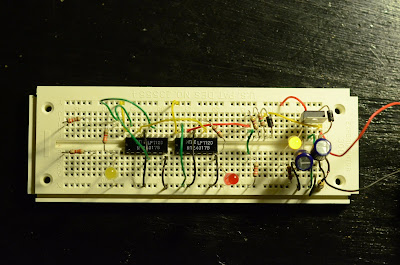Sorry about the lack of posts lately. I have been crazy busy with work, not to mention the three vacations I have had back to back (believe it or not, that can be a bit tiring--but don't get me wrong, I would do it all over again). Anyways, enough about me, I have pictures of the power supply!

That large black cylinder is the inductor (in case you were wondering). Look at the previous post for a schematic. I got almost every single part from Digikey. Aside from the inductor, I received enough parts to make almost five of these power supplies with a final cost of around $40-$50. Not too bad if you ask me. Buying in bulk obviously reduces the prices even further. Not shown is the 9VDC power supply, which I am currently borrowing from my other nixie clock.
I thought originally that I had purchased a high-voltage 2.2uF capacitor (C4), but it turns out I missed it when I did the ordering. The large gray rectangular box is a 0.68uF capacitor rated at 310V. I yanked it from a broken computer power supply I had sitting around. I would have been pretty angry if I hadn't found it... crisis averted! Turns out the 0.68uF capacitor works just fine instead of the 2.2uF cap.
The back-side doesn't look too pretty, but it's a project board, what do you expect?? I'll upgrade to PCB (printed circuit board) eventually!
So, success! I get an output of 170VDC (adjustable by adjusting the potentiometer--the blue rectangular box) out of the red wire (red means DANGER!). I also get a convenient 5VDC output I can use for the integrated circuits out of the yellow wire. Black is common for both outputs. I'll see if I can't eventually post a picture of the nixie tube hooked up. I know this works from experience, but it would be nice to show it on the blog.
Next, I need to figure out a way to get the timing on the clock right. This has been bothering me for a bit since I would like to avoid using PICs (programmable integrated circuits), but the only reliable way to get a timed pulse that will be accurate over months or years with a DC input is to use a crystal oscillator. These puppies put out thousands to millions of pulses per second... bringing that down to 1 pulse per second will take a large number of divider circuits. Ok, I'll get back to you on this! 'Till next time!
share on:
facebook







